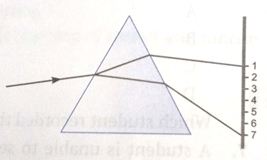Human Eye & Colourful World
Que 1. Is the position of a star as seen by us in its true position? Justify your answer.
Ans. No, light from stars undergoes atmospheric refraction which occurs in medium of gradually changing refractive index.
Que 2. Does a beam of white light give a spectrum on passing through a hollow prism?
Ans. No, this is because dispersion of light cannot occur through a hollow prism containing air.
Que 3. A beam of white light falling on a glass prism gets split up into seven colours marked 1 to 7 as shown in the diagram.
A student makes the following statements about the spectrum observed on the screen.
(a) The colours at positions marked 3 and 5 are similar to the colour of the sky and the colour of gold metal respectively.
Is the above statement made by the student correct or incorrect? Justify.
(b) Which two positions correspond closely to the colour of
(i) brinjal, (i) 'danger' or stop signal lights?

Ans. (a) The statement made by the student is incorrect. Positions marked 3 (yellow) and 5 (blue) are similar to the colour of gold metal and the colour of the sky respectively. The student is stating the nature of colours in reverse order.
(b) (i) The position marked 7 corresponds closely to the colour of a brinjal.
(ii) The position marked 1 (red) corresponds closely to the colour of ‘danger’ or stop signal lights.
Que 4. Why sometimes haloes or rings are observed round the moon or sun?
Ans. When the moon or the sun is observed through a thin layer of the high clouds, reflection of light from fine icy crystals, present in the clouds, result in the formation of haloes.
Que 5. Can an observer see a rainbow on the moon?
Ans. No, since there is no atmosphere on the moon.
Que 6. Why does a person suffering from hypermetropia prefer to remove his spectacles while looking at distant objects? Explain.
Ans. A hypermetropic eye can have normal far point. If he uses spectacles of converging lens, he will have more converging power than needed for parallel rays so the distant object may get focused in front of the retina and so distant objects will appear blurred.

